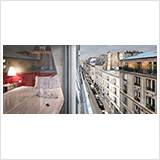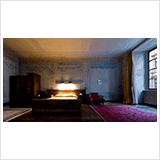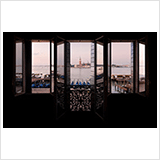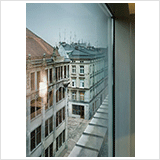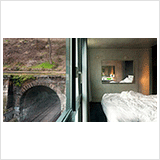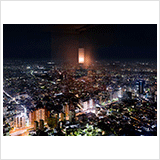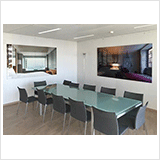
"Ik vind het leuk om Nederlandse kunst op mijn werkkamer te promoten. Hier ziet u twee werken van de Delftse kunstenaar/fotograaf Willem van den Hoed. Hij maakt prachtige foto's van hotelkamers over de hele wereld. Niet zomaar foto's, ze zijn haarscherp omdat ze worden opgebouwd uit heel veel foto's. Er zit altijd een zeer zorgvuldige planning en compositie achter. En er wordt op een uniek "Hollandse" manier met licht gespeeld. Zou het toeval zijn dat hij uit dezelfde stad komt als Johannes Vermeer? Links ziet u een hotelkamer in Hong Kong, rechts in Krakow. Het felle licht dat door de raamwand overdag mijn werkkamer in schijnt, zorgt voor verrassende reflecties in de foto's, waardoor ze nog expressiever en intrigerender worden. En ik ben door mijn werk de afgelopen decennia een zeer, zeer frequent gebruiker van hotelkamers, dat maakt het nog leuker." (2015)
Facebook pagina | Frans Timmermans
Appearantly Empty by Hugo Beschoor Plug
In the opening scene of the 2005 film Caché, Michael Haneke takes the viewer to the 13th Arrondissement in Paris. The camera is located in Rue des Iris and is aimed at Rue Brillat-Savarin which crosses it. Apart from a few parked cars and a scooter, both streets are empty. There is not a soul in sight; neither on the street, nor in the windows, nor on the balconies. The background noises – birdsong and some distant traffic – suggest that it is early morning. The scene serves as a background for the titles, which appear one by one. When all the titles have gone, the viewer is left alone with the fixed view of the street. Nothing seems to be happening. After an exasperating 52 seconds, Haneke allows a boy to walk from right to left along Rue Brillat-Savarin and cross the field of vision. This incident, innocuous in itself, sets the scene in motion. The city awakes. After 104 seconds, Juliette Binoche leaves her house. A cyclist and a car subsequently pass by. Finally, as two women walk across the screen, Haneke ends the scene after 166 seconds.
By filming a long, almost motionless opening scene from a fixed camera position, Haneke immediately builds up tension. My feeling is that this scene cannot last long enough for Willem van den Hoed. The fleeting movements of the people will not escape his attention, but his main attention will be on Haneke’s starting point: the apparently empty Parisian street scene. Apparently empty, because if the scene were to last any longer, more and more movement would become visible: the varying intensity of the sunlight, the colour of the blank walls, the reflections in the car mirrors, the intensifying shadows and the slight movements of leaves and curtains. Observation of these gradual changes forms the basis for Van den Hoed’s photographic work.
In the exhibition ‘Hotel Rooms’, he displays the result of these observations based on six hotel rooms in Geneva, Hong Kong, Munich, Paris and Rotterdam. Hotel rooms with a view over the city, such as room 62 of Hotel Mayet in Paris. The viewpoint of the work, 62, is located just outside the window of this room. The zinc gutter of the roof forms the demarcation line between the hotel room and Rue Mayet. It is difficult to judge the time of day; the sunlight playing on the street and the occasional lights switched on indoors provide no clear-cut information. There is an unstable balance between light and darkness. Nothing seems to be happening; time seems to be the only thing that is passing. The absence of people in the hotel room and the everyday appearance of the street lead you to no particular conclusions. Nevertheless, our eyes flicker across the screen in search of some clue. The intense clarity of every detail – near at hand in the room’s interior, far away in the street and reflected in the window – challenges us to ever greater scrutiny. Van den Hoed spends a lot of time in Hotel Mayet. Between his arrival on Sunday, 12 October 2008 and his departure on Tuesday, 14 October 2008, he works on a rich but incomplete collection of snapshots that document events in and around room 62. Over several sessions, he photographs in minute detail the slow changes evolving in the room and in the view outside. This collection, the result of patience interspersed with intense activity, is eventually condensed in to the work 62. Because 62 is composed of details photographed at different points in time, the work as a whole takes on an unreal character. We see one place, it is true, but we also see many points in time.
In none of the hotel rooms are people to be seen. One has the impression that the guests have deserted the rooms. Van den Hoed, however, has stayed behind and taken his photographs. His work does not merely show us empty rooms. On the contrary, the rooms are filled with movement: the way in which light moves over the course of time; the changes in the views of the cities; the reflections in the glass, mirrors and other reflective surfaces, and the varying intensity of the light. By observing, as an ‘invisible man’, an apparently empty room over a long period and then bringing together these observations in a single work, Van den Hoed creates a new, layered reality. A reality that invites us to enter the room and stand next to the photographer. That is, if that place has not already been taken by Haruki Murakami, the Japanese writer who, in his novel After Dark, so accurately describes the events in a deserted and apparently empty room:
She hangs the bag on her shoulder and walks out of the restroom. The door closes.
Our viewpoint camera lingers in here for a while, observing the restroom. Mari is no longer here. Neither is anyone else. Music continues to play from the ceiling speaker. A Hall and Oates song now: I Can’t Go for That. A closer look reveals that Mari’s image is still reflected in the mirror over the sink. The Mari in the mirror is looking from her side into this side. Her sombre gaze seems to be expecting some kind of occurrence. But there is no one on this side. Only her image is left in the Skylark’s restroom mirror.
The room begins to darken. In the deepening darkness, I Can’t Go for That continues to play.
From the catalogue hotel rooms (2009) | translated by Christopher Smith | excerpt After Dark with permission of RANDOM HOUSE
Alleen al het kleurverloop is prachtig. Van het intense roodviolet van het vloerkleed rechtsonder, via de gelen en witten in het centrum naar het fijn gedifferentieerde palet van bruine houttinten links. Dat alles tegen een met subtiele kleuraccenten verlevendigd grijs fond.
En dan de scherpte! Die levert op zich al een werkelijk ongekende ervaring op.
In een foto van Willem van den Hoed houdt het kijken nooit op. Ieder detail is raak. Van het hoogste licht tot de diepste schaduw blijft de tekening helder en scherp. Waar je ook kijkt en hoever je ook inzoomt, overal vormen de kleuren verrassende en subtiele harmonieën. Dit is schilderen met de camera, niet zomaar, maar schilderen volgens de regels van het oude métier, met inzet van het hele academische apparaat van formele en technische middelen.
101, is de titel van een van de recente werken. Ook deze foto is samengesteld uit honderden kleinere en laat een ongelofelijke scherpte en kleurdiepte zien. Op een meer dan riant breedbeeldformaat (124 x 227) zien we een hotelkamer waarvan de grootsheid van stijl omgekeerd evenredig is aan de staat van onderhoud. De titel zal wel verwijzen naar het kamernummer. Voor je geest verschijnt een gebouw vol van dit soort ruimten. Allemaal kortstondig bewoond door een eindeloze rij gasten, van de elite van een oude wereld tot aan een enkele verdwaalde toerist nu. Waar we zijn hoeven we niet te weten; ergens in het oude Europa wellicht. Door het raam zien we een oude stad uit velen.
De mens als reiziger in tijd en ruimte, het thema van de hotelkamer laat zich makkelijk duiden als metafoor van het nomadische bestaan in een kosmopolitische wereld.
Zijn echte betekenis openbaart het werk echter pas in de samenspraak van thema en zienswijze, in het wat en het hoe. In de wereld van Willem van den Hoed is er geen verschil tussen dichtbij en veraf. Waar je ook kijkt, alles is even scherp, even aanwezig. Dichtbij en veraf, is dat niet hetzelfde als nu en toen? Of als binnen en buiten, ik en de wereld. Het is alsof de kunstenaar de werkelijkheid in zijn geheel, met al zijn uitersten en contrasten, heeft verdicht tot één plat vlak. De tijd staat stil, je blijft kijken.
artupdate.nl | Ko van Dun
226 (124x198cm) is het meest recente werk uit de serie hotel rooms van Willem van den Hoed. In deze werken, opgebouwd uit ontelbare detail- en momentopnamen, worden nieuwe gelaagde werkelijkheden gecreëerd.
In 226 zet Van den Hoed tegenover het horizontale spiegelvlak van het water in het Bacino di S. Marco een serie van vertikale spiegelvlakken: de geopende vensters van kamer 226 van Hotel Danieli aan de Riva degli Schiavoni in Venetië. De reflecties in het vensterglas snijden het uitzicht vanuit de hotelkamer in delen en construeren een ongekende Venetiaanse horizon.
PAN Amsterdam catalog (2010)
Tijdens zijn verblijf in Hotel Sofitel Wroclaw Old Town fotografeert
Willem van den Hoed minutieus en gedetailleerd de langzame veranderingen die zich binnen in kamer 518 en buiten op straat voltrekken. Deze verzameling, het resultaat van geduld afgewisseld met intensieve
activiteit, wordt in zijn atelier in Delft gecondenseerd in het werk 518 (140x100cm). Doordat 518 opgebouwd is uit details, die op verschillende momenten gefotografeerd zijn, krijgt het geheel een onwerkelijk karakter. We zien weliswaar één plek, maar tevens vele tijden.
Willem van den Hoed (1965) is opgeleid als architect. Sinds 2000 maakt hij foto-werken, die geëxposeerd worden in binnen- en buitenland. Hij wordt gerepresenteerd door Galerie de Zaal in Delft, die 518 als deel van de serie Hotel Rooms zal tonen op PAN Amsterdam van 20 t/m 28 november 2010 (stand 103).
Architectuur Lokaal magazine (2010)
Het Mama Shelter Hotel in Parijs is ontworpen door Philippe Starck.
Het is een nieuw concepthotel dat moet appelleren aan de smaak van de stedelijke digitale generatie.
Willem van den Hoed brengt het betonnen interieur van kamer 120 met
minimalistisch comfort en spiegels waarin de high-tech materialen
eindeloos worden weerspiegeld face-to-face met het historisch panorama op La petite Ceinture (de kleine riem).
Tijdens de wereldtentoonstelling van 1889 bracht dit spoor vijf
miljoen mensen naar de revolutionaire Eiffeltoren. In 1985 verdween de laatste trein en het tracé transformeert inmiddels tot een biodivers natuurgebied met fietspaden, 1500 soorten vleermuizen, bossen en bijenkorven.
La petite ceinture verandert in een anneau de miel; een ring van honing!
PAN Amsterdam catalogue (2012)
In his series Hotel Rooms, Willem van den Hoed brings together three elements: interior, exterior and the glass that separates them. In his works he looks for a balance between these elements: layered realities, composed from countless detailed and random shots.
In 4814 (182x250cm), which he photographed in Park Hyatt Tokyo, the interior of the hotel is only present as a reflection in the glass that gives a view of an extensive city. The field of tension built up by Willem van den Hoed depends from the position of the spectator in relation to the work.
Closer, the structure of the city is visible in every detail, from the dark quietness on the cemetery to the nocturnal activities in a 7-Eleven supermarket. The reflection of the hotel room is merged into the nocturnal image of Tokyo. However, from some distance the infinite details of the city fuse together into a sea of lights and the reflection of room 4814 is clearly visible. The lamp, dominating the interior of the room, turns out to be one of the lights of the city. We have arrived.
what's up magazine, 2011_nr.8 (2010)
